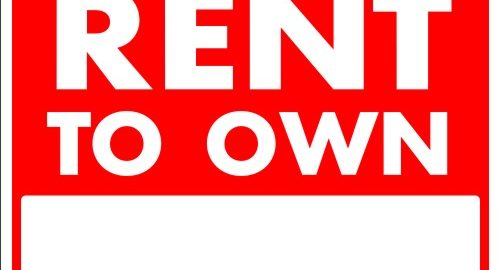This post is about rent to own agreements, but I will first talk about how I got there by studying wholesaling first. When I was discussing with my mentor (Yes, you should have a real estate investing mentor!!) about what strategy to start with, he suggested Wholesaling. Wholesaling basically involves agreeing to a purchase and sale agreement to buy a house, but then “assigning” that agreement to another investor for a fee (usually between $1000 and $5000). The trick is to find really great deals, so you will need a great real estate agent and then a lawyer that knows how to handle assignment contracts. See 8 People you Need as a Real Estate Investor for more info. Once you have a great deal under contract, you can sell the right to that great deal to other investors. Basically, you’re doing the legwork for other investors for a nice fee. Sounds simple enough, right?!
The trouble I ran into in my area is that nobody knew what I was talking about and were very skeptical about it. The hang up was on the legal end as most figured that assigning a purchase and sale agreement to another buyer is not permitted. In fact, it is permitted in Canada, but more common in city centers with condos. Often a buyer will purchase a condo long before it’s built, then assign it to another buyer when the unit is complete. With wholesaling not likely to work out for me in my small area, I moved on to the next lowest on investment risk factor, which was rent to own.
Rent to own agreements are similar to normal renting of your property with the addition of including a purchase option into the contract for the tenants living there. The way I looked at it was providing a client that would not be able to qualify for a mortgage that this moment the opportunity to have their own home. Yes, my name is on the title and I pay the mortgage, but the tenants are responsible for everything. I basically leave them alone and let them live their lives as if they owned the home. Of course I do an inspection of the property at least once per year and start tightening the chain if money becomes as issue (you’ll hear about one bad tenant I had!).
Here’s the general outline of a rent to own deal.
- I post an ad looking for clients interested in owning their own home, but cannot qualify for a mortgage. The replies, as you might imaging, are very plentiful!
- Any inquiries I get I send back an email with what to expect with rent to owns. I require at least $5000 for a down payment and an additional 20% per month on top of the rent. All this goes towards the eventual purchase of the home. I also add at least 2% per year to the purchase price of the home. The above scares off 95% of the people who email me!
- Those that weren’t scared off and replied back get sent another email with more detailed information about the process as well as an application.
- Those that actually send the application back go through a vetting process. This is where I would check their credit, see if they make enough money to make this work, call their references, and look at their preferences for homes.
- I then choose a suitable client to begin the process of looking for homes.
- Based on their criteria, I have my realtor send me a list of suitable homes, which I then forward to the potential clients
- We then go through the homes with the potential clients. We don’t let the clients through homes on their own. We got into trouble on one deal when it was time to purchase. The selling agent was very upset when my realtor came forward with an offer and essentially taking half of his commission. Always make sure your realtor is setting up all property viewings to avoid this confusion.
- Once a property has been chosen. I sit down with a client to discuss terms. The most important terms being the initial purchase price, amount of down payment client can afford, monthly rent plus the added monthly down payment amount, yearly appreciation about (2% as I mentioned above), and of course term length. I would do a minimum of 2 years with a max of 5 years.
- Once we have a signed agreement I will put in an offer to purchase the property. Once I have an accepted offer, I ask the client for half of the down payment.
- Prior to the move in date, the rest of the down payment and first month’s rent is due
- The clients pay the rent and the added monthly down payment each month until the end of the contract. The clients are responsible for all maintenance and repairs to the property. Much like any homeowner would. I hold the insurance for the property and also pay property taxes.
- At the end of the agreement, the appreciation value is added to the initial purchase price minus their initial down payment and monthly down payments.
None of the terms and numbers I’ve used are set in stone. This is what has worked for me, but there’s always room for improvements and tweaking.
I’ve done two of these rent to own agreements so far in my real estate investing career. The first one has gone beautifully and I’ll be selling it to the clients this December. The second was trouble right from the start and I recently sold the property at a break-even price just so I don’t have to look at it or think about it again. Look for stories on these properties in the months to come.
Also, any application, agreement, ad or email I send to clients I will be offering on this site very soon!







 Thank you for taking the time to visit my blog. My name is Kevin and I am the owner of smalltownriches.com, where you'll follow me on my journey as a rural entrepreneur! I have a full time job, but i'm also an avid real estate investor and look for any other opportunity I can to supplement my income. I also have a passion for dogs and hope to one day run my own rescue once I can leave my full time job. Questions and comments are encouraged!
Thank you for taking the time to visit my blog. My name is Kevin and I am the owner of smalltownriches.com, where you'll follow me on my journey as a rural entrepreneur! I have a full time job, but i'm also an avid real estate investor and look for any other opportunity I can to supplement my income. I also have a passion for dogs and hope to one day run my own rescue once I can leave my full time job. Questions and comments are encouraged!










